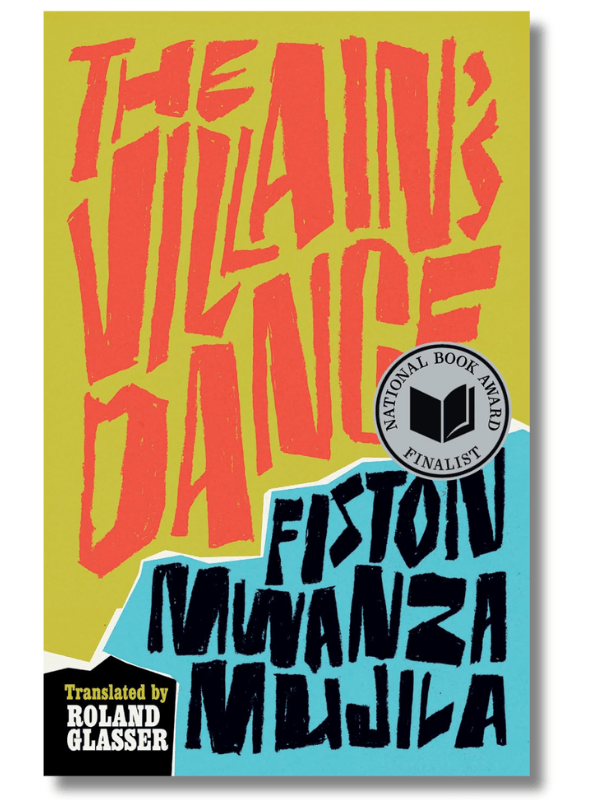The Villain’s Dance
by Fiston Mwanza Mujila
Genre: Literary Fiction / Family Life
ISBN: 9781646051274
Print Length: 272 pages
Publisher: Deep Vellum Publishing
Reviewed by Eric Mayrhofer
Poetic and inventive, Fiston Mwanza Mujila’s The Villain’s Dance sees—and mourns—the Angola that could have been.
There are times when the momentous occurs, when you see clear as day the before and the after, the exact moment that life irrevocably changed. For many, that might be a loved one’s death. For Tshiamuena, one of the central characters in Fiston Mwanza Mujila’s The Villain’s Dance, it is the missed opportunity for Angola to eschew the sway of White colonialism and achieve its own greatness.
In the novel’s opening pages, Tshiamuena reveals that after the revolution removing the country from foreign rule, Angola “was becoming a colander. Porous borders. A stampede in both directions. [Young Zairians] breezed in by the dozens, by the hundreds, carrying all sorts of goods. Angola was cut off from the world. And staples…were snapped up like you haven’t the slightest idea. We bartered gems for these products thousands of times.”
Throughout the novel, readers see her presiding over ambitious Angolan miners as a mix of spiritual prophet, memory keeper, governor, and mascot. She is a woman who builds her own myth by shrouding her very age in mystery—was she born in the twentieth century or the fifteenth?—and she is, as her would-be biographer Franz puts it, “a lady who’s a little too full of herself.”
First and foremost, however, Tshiamuena is a mourner grieving a nation that could have been. She watches human chains of miners bring up diamonds from the Angolan dirt, gems that have no value until they leave the country and arrive in Belgium, where presumably White Europeans decide their worth.
This situation could have been avoided, but as Tshiamuena sees repeatedly, her people miss the bigger picture, the true wealth. They trade their diamonds away for more worthless things that are more immediately attainable. Why? Because fulfilling desires, even if you fulfill them with worthless things, can bring the illusion of wealth.
Readers see that dynamic over and over again in The Villain’s Dance as the novel flits from Tshiamuena to both Franz and two other boys: Molakisi, who runs away from home to realize his (wholly unoriginal) dreams of being rich, and Sanza, who begins the story homeless as a direct result of Molakisi’s actions.
While the story itself is somber, following these characters through their hardships is a delight. Mujila’s voice is commanding without being obvious, drawing readers in with an inviting, conversational tone that feels like someone talking to you. Readers will be dozens of pages in before realizing how far and fast they’ve been swept along.
The prose is inventive as well. The book opens with vivid, tall tale description of Tshiamuena, for instance. “Tshiamuena this, Tshiamuena that. Tshiamuena’s got wings, big wings, and as soon as night falls, this witch takes off and flits about for miles and miles,” the gossiping hordes say, but this larger-than-life portrait is a gateway into learning about the setting—Angola after rebellion.
By the same token, readers learn that Franz, a character seemingly disconnected from everything in Angola if it weren’t for his fascination with Tshiamuena, is plagued by “insane perfectionism. For him, the sentence was what really counted in a novel. He gauged each one in the manner of an ophthalmologist examining his patients’ eyes.” At every turn, Mujila chooses an oblique or character-driven angle to explore the novel’s larger themes, and The Villain’s Dance is more breathtaking for the choice.
That approach also ensures that The Villain’s Dance always circles back to its main questions: What is true wealth? Is giving over to your base desires ever truly fulfilling? And is it better overall to live in reality, to see a humbled self and a broken world for what they are, or to live in the beautiful legends we build for ourselves? Tshiamuena may grieve discovering the answers, but readers will revel in exploring these ideas—and this story—for themselves.
Thank you for reading Eric Mayrhofer’s book review of The Villain’s Dance by Fiston Mwanza Mujila! If you liked what you read, please spend some more time with us at the links below.
The post Book Review: The Villain’s Dance appeared first on Independent Book Review.
